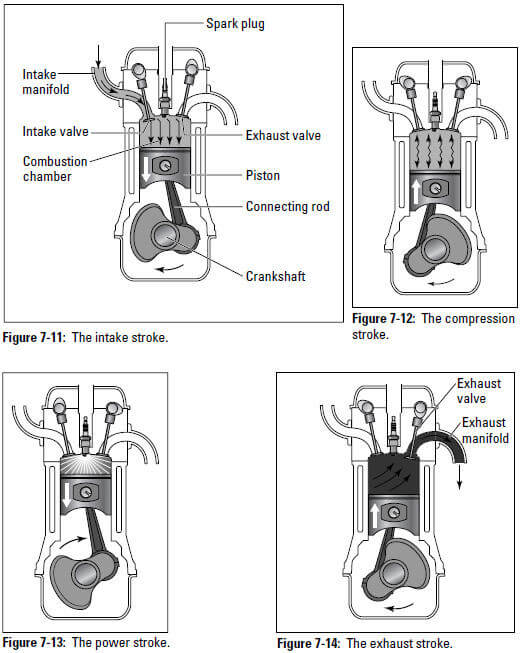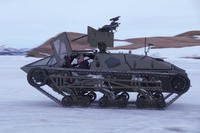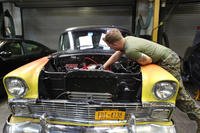The piston rides up and down inside the cylinder on a connecting rod that attaches to the crankshaft, causing the crankshaft to turn. Each movement of the piston is called a stroke. Four strokes — down, up, down, up — complete the cycle that creates the power to drive the engine. This process is aptly called the four-stroke power cycle. The four-stroke power cycle varies slightly depending on whether your vehicle's engine is a conventional internal combustion engine or a diesel engine.
Here's what happens on each stroke of the piston in a conventional internal combustion engine:
1. Intake stroke: See Figure 7-11. When the piston moves down, it creates a vacuum in the top portion of the cylinder (where the piston was at the end of its last upstroke). Air can't get in from the bottom of the cylinder because the rings on the piston seal it off. Then the intake valves, conveniently located in the cylinder head, open up and let the fuel/air mixture into the cylinder. This mixture rushes in to fill the vacuum left by the piston.
2. Compression stroke: See Figure 7-12. The piston moves back up, compressing the fuel/air mixture into a tiny space between the top of the piston and the top of the cylinder. This space is called the combustion chamber and also happens to be where the end of the spark plug enters the cylinder. The difference between the total space inside the cylinder and the space inside the combustion chamber is called the compression ratio. It indicates that the pressure has been raised from normal air pressure of 15 psi (pounds per square inch) to hundreds of psi,which makes the resulting explosion much more intense.
At this point, the intake valves have closed, so the compressed mixture can't get out. (The intake and exhaust valves create airtight seals to ensure that nothing can get past them when they're closed.)
3. Power stroke: See Figure 7-13. The spark plug produces a spark across the gap between its electrodes. This spark ignites the compressed fuel/air mixture. Then the burning fuel/air mixture ignites, creating intense pressure that forces the piston down again. The power that pushed the piston down is transmitted, via the connecting rod, to the crankshaft. It then travels, via the drive train, through the clutch or torque converter, the transmission, the driveshaft, the differential, and so on to the wheels.
4. Exhaust stroke: See Figure 7-14. The piston moves up again, pushing the burned gases up with it. Then the exhaust valve opens and lets the burned gases out into the exhaust manifold. From there, the burned gases travel through the exhaust system (which includes antipollution devices), through the muffler, and out the tailpipe into the environment.
 |
The cylinders don't fire all at once. To keep the engine properly balanced with all that action going on, they fire in a particular order called the firing order. So while one cylinder is going through the intake stroke, another will be at the compression stroke, and so on.
When you understand the four-stroke power cycle it's easier to see why the diagnostic inspectioins and service required by your warranty are so important. Spark plugs are checked and replaced because, if the spark is insufficient or the timing is off, the result is less power and incompletely burned fuel. Increased air pollution and fuel consumption are high prices to pay for stretching the intervals between spark plug replacements, especially because they're much less frequent than before!
From Auto Repair for Dummies, copyright © 2009 by Wiley Publishing, Inc., Indianapolis, Indiana. Used by arrangement with John Wiley & Sons, Inc.










